|
|
|
Sort Order |
|
|
|
Items / Page
|
|
|
|
|
|
|
| Srl | Item |
| 1 |
ID:
122740


|
|
|
|
|
| Publication |
2013.
|
| Summary/Abstract |
As the capital of China, Beijing is regarded as a major metropolis in the world. Study of the variation in temporal CO2 emissions generated by the driving forces in Beijing can provide guidance for policy decisions on CO2 emissions mitigation in global metropolises. Based on input-output structural decomposition analysis (IO-SDA), we analysed the driving forces for the increment in CO2 emissions in Beijing from both production and final demand perspectives during 1997-2010. According to our results, the CO2 emission growth in Beijing is driven mainly by production structure change and population growth, partly offset by CO2 emission intensity reduction as well as the decline in per capita final demand volume during the study period. Final demand structure change has a limited effect on the change in the CO2 emissions in Beijing. From the final demand perspective, urban trades, urban residential consumption, government consumption and fixed capital formation are mainly responsible for the booming emissions. This study showed how the "top-down" IO-SDA methodology was implemented on a city scale. Policy implications from this study would be helpful for addressing CO2 emissions mitigation in global capital cities and metropolises.
|
|
|
|
|
|
|
|
|
|
|
|
|
|
|
|
| 2 |
ID:
128417


|
|
|
|
|
| Publication |
2014.
|
| Summary/Abstract |
Increasing use of energy has helped to stimulate China's economy. Despite central planning, China has great differences in economic development, energy endowment and energy consumption across its regions. This paper uses the structural decomposition approach to uncover the regional disparities in energy consumption from 1987 to 2007. We also examine six possible key factors for the change in energy consumption by region. We find that final demand change outpaced efficiency improvements to drive up energy use in all regions between 1987 and 2007. More surprisingly, from 2002 to 2007, it appears that changes in production structure enhanced energy consumption in most regions. China produced more energy-intensive goods for capital investment and export. We contend that improving the energy efficiency of key energy-intensive sectors would lead a significant decline in energy intensity. Energy, directly or indirectly, is flowing from Northwest, Central and North China to coastal regions. Regional-specific policies should be designed to promote production structure change and curb energy demand.
|
|
|
|
|
|
|
|
|
|
|
|
|
|
|
|
| 3 |
ID:
109628


|
|
|
|
|
| Publication |
2011.
|
| Summary/Abstract |
To gain insight into changes in CO2 emissions embodied in China-US trade, an input-output analysis based on the emergy/dollar ratio (EDR) is used to estimate embodied CO2 emissions; a structural decomposition analysis (SDA) is employed to analyze the driving factors for changes in CO2 emissions embodied in China's exports to the US during 2002-2007. The results of the input-output analysis show that net export of CO2 emissions increased quickly from 2002 to 2005 but decreased from 2005 to 2007. These trends are due to a reduction in total CO2 emission intensity, a decrease in the exchange rate, and small imports of embodied CO2 emissions. The results of the SDA demonstrate that total export volume was the largest driving factor for the increase in embodied CO2 emissions during 2002-2007, followed by intermediate input structure. Direct CO2 emissions intensity had a negative effect on changes in embodied CO2 emissions. The results suggest that China should establish a framework for allocating emission responsibilities, enhance energy efficiency, and improve intermediate input structure.
|
|
|
|
|
|
|
|
|
|
|
|
|
|
|
|
| 4 |
ID:
175255
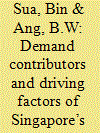

|
|
|
|
|
| Summary/Abstract |
Singapore is an island city state. It lacks conventional energy resources and is alternative energy disadvantaged. Yet its aggregate carbon intensity, given by the ratio of carbon emissions to GDP, dropped by 30% from 2005 to 2014. Currently it has a relatively low carbon intensity. Using I–O analysis, we study Singapore’s aggregate carbon intensity and the factors contributing to its changes at different levels, i.e. final demand, sector, and transmission levels. It is found that domestic exports accounted for nearly two-thirds of Singapore’s aggregate carbon intensity, followed by private consumption and investment. At the sectoral level, the top three contributors were the petroleum, petrochemical, and land transport sectors. Improvements in emission intensity and final demand structure were major factors contributing to reductions in carbon intensity. Our study contributes to the literature in two aspects. Methodologically, it deals with embodied emission intensity and analyzes its changes from the demand perspective. This differs from most studies in the literature from the production perspective. Empirically, the findings and policy implications are unique as they are applicable to a major city. With urbanization taking place in many developing countries, cites’ role in emissions and environmental sustainability are growing in importance but not many in-depth analyses similar to our study have been reported.
|
|
|
|
|
|
|
|
|
|
|
|
|
|
|
|
| 5 |
ID:
181427


|
|
|
|
|
| Summary/Abstract |
China's rapidly rising freight transport demand has been one of the primary contributors to global oil consumption growth since 2000 and has remained the dominant source of domestic transport energy consumption during the same period. The objective of this paper is to investigate the main structural driving forces of China's freight transport demand during its fastest growing period (1997–2012), and to analyze its potential future scenario. The results suggest that strong growth of total final demand, an increasingly freight-intensive economic structure, and lengthening inter-industry production linkages, which is consistent with China's investment and export driven development model from 1997 to 2012, have been the main propellers of rapid freight transport demand growth during this time. Looking ahead, as the Chinese economy gradually shifts to a consumption driven model in an increasingly uncertain global economic environment, policymakers need to be aware of both unexpected demand shocks and the inherent changes of the Chinese economy while considering their implications for China's transport energy demand and China's carbon emission mitigation strategy.
|
|
|
|
|
|
|
|
|
|
|
|
|
|
|
|
| 6 |
ID:
097204
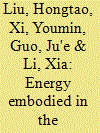

|
|
|
|
|
| Publication |
2010.
|
| Summary/Abstract |
Growing international trade has not only positively affected the People's Republic of China's (China's) economic development, but also expanded the exportation of energy embodied in goods during their production. This energy flow out will pose risks to China's rational utilization of natural resources as well as environmental protection. In this paper, we evaluate the energy embodied in goods produced in China during 1992-2005 and use input-output structural decomposition analysis to identify five key factors causing the changes of energy embodied in exports. (Direct primary energy efficiency, primary energy consumption structure, structure of intermediate inputs, structure of exports, and scale of exports.) For the three sub-periods of 1992-1997, 1997-2002, and 2002-2005, results show that China is a net exporter of energy, and the energy embodied in exports tends to increase over time. The expanding total volume of exports and increasing exports of energy-intensive goods tend to enlarge the energy embodied in exports within all three sub-periods, but these driving forces were offset by a considerable improvement of energy efficiency and changes in primary energy consumption structure from 1992 to 2002 and the effects of structure of intermediate input only in the sub-period from 1992 to 1997. From 2002 to 2005, the sharp augmentation of energy embodied in exports was driven by all the five factors. Our research has practical implications for the Chinese economy. Results of this study suggest that the energy embodied in trade should receive special attentions in energy policies design to limit the energy resource out-flow and pollution generation.
|
|
|
|
|
|
|
|
|
|
|
|
|
|
|
|
| 7 |
ID:
124688


|
|
|
|
|
| Publication |
2013.
|
| Summary/Abstract |
In order to uncover driving forces for provincial CO2 emission in China, a case study was undertaken to shed light on the CO2 emission growth in such a region. Liaoning province was selected due to its typical features as one industrial province. The environmental input-output analysis and structure decomposing analysis have been conducted in order to provide a holistic picture on Liaoning's CO2 emissions during 1997-2007. Research outcomes indicate that rapid increase of per capita consumption activities is the main driver for Liaoning to have a significant CO2 emission growth, followed by consumption structure, production structure and population size. Energy intensity and energy structure partly offset the CO2 emission increase. Electricity power and heat supply and construction sectors caused the most CO2 emission, indicating that more specific mitigation policies for these two sectors should be prepared. From final demand point of view, it is clear that trade plays a leading role in regional CO2 emission, followed by fixed capital investment and urban household consumption which become increasingly important over time. Consequently, in order to realize low carbon development, local governments should consider all these factors so that appropriate mitigation policies can be raised by considering the local realities.
|
|
|
|
|
|
|
|
|
|
|
|
|
|
|
|
| 8 |
ID:
149872


|
|
|
|
|
| Summary/Abstract |
Thailand has depended heavily on imported fossil fuels since the 1990s, which hindered the nation's economic development because it created uncertainty in the nation's fuel supply. An energy conservation policy was implemented in 1995 to require industries to reduce their energy intensity (EI) and consumption immediately. This study investigates the effectiveness of the policy between 1995 and 2010 using the hybrid input–output approach. Surprisingly, EI improvement was observed in only a few sectors, such as transportation, non-metallic, paper, and textile. An embodied energy decomposition analysis revealed that while households were the largest energy consumer in 1995, energy consumption in exports exceeded that of households in 2000, 2005 and 2010. In addition, structural decomposition analysis revealed the final demand effect was the strongest factor in determining the efficacy of energy conservation, whereas the energy efficiency effect was not an effective factor as expected for decreasing energy consumption. Policy barriers and conflicting economic plans were factors that affected the outcome of these energy policies.
|
|
|
|
|
|
|
|
|
|
|
|
|
|
|
|
| 9 |
ID:
192745


|
|
|
|
|
| Summary/Abstract |
This study innovatively divided consumption-based CO2 emissions of developed countries into domestic and foreign components using an environmentally extended multi-regional input–output model, and revealed their different driving factors using the structural decomposition analysis method. The results showed that the consumption-based emission peaked in 16 developed countries, with 14 countries peaking around 2008. Domestic emissions in all 16 developed countries had peaked, most of which accounted for 40–70% of the total consumption-based emissions. However, the foreign emissions driven by 9 peaking countries still kept increasing. Regarding domestic emissions, the decline of domestic carbon intensity was the main driving factor across 16 peaking countries. In terms of foreign emissions, carbon intensity decline, especially in main medium- and low-income countries, was the dominant factor in the CO2 emissions decrease. Significant improvements in production technology levels of medium-income countries played a key role in weakening the carbon-increasing effects of foreign emissions during the post-peak period. Thus, to further promote global carbon emissions to peak as soon as possible, peaking developed countries should provide more emission reduction funds and technologies to support the decline in carbon intensity and the improvement of production technology in medium- and low-income countries.
|
|
|
|
|
|
|
|
|
|
|
|
|
|
|
|
| 10 |
ID:
150780


|
|
|
|
|
| Summary/Abstract |
The aim of this paper is the analysis of structural decomposition of changes in CO2 emissions in Spain by using an enhanced Structural Decomposition Analysis (SDA) supported by detailed Input–Output tables from the World Input–Output Database (2013) (WIOD) for the period 1995–2009. The decomposition of changes in CO2 emissions at sectoral level are broken down into six effects: carbonization, energy intensity, technology, structural demand, consumption pattern and scale. The results are interesting, not only for researchers but also for utility companies and policy-makers as soon as past and current political mitigation measures are analyzed in line with such results. The results allow us to conclude that the implementation of the Kyoto Protocol together with European Directives related to the promotion of RES seem to have a positive impact on CO2 emissions trends in Spain. After reviewing the current mitigation measures in Spain, one policy recommendation is suggested to avoid the rebound effect and to enhance the fight against Climate Change that is tax benefits for those companies that prove reductions in their energy intensity ratios.
|
|
|
|
|
|
|
|
|
|
|
|
|
|
|
|
| 11 |
ID:
128411


|
|
|
|
|
| Publication |
2014.
|
| Summary/Abstract |
The decline of China's energy intensity slowed since 2000. During 2002-2005 it actually increased, reversing the long-term trend. Therefore, it is important to identify drivers of the fluctuation of energy intensity. We use input-output structural decomposition analysis to investigate the contributions of changes in energy mix, sectoral energy efficiency, production structure, final demand structure, and final demand category composition to China's energy intensity fluctuation during 1997-2007. We include household energy consumption in the study by closing the input-output model with respect to households. Results show that sectoral energy efficiency improvements contribute the most to the energy intensity decline during 1997-2007. The increase in China's energy intensity during 2002-2007 is instead explained by changes in final demand composition and production structure. Changes in final demand composition are mainly due to increasing share of exports, while changes in production structure mainly arise from the shift of Chinese economy to more energy-intensive industries. Changes in energy mix and final demand structure contribute little to China's energy intensity fluctuation. From the consumption perspective, growing exports of energy-intensive products and increasing infrastructure demands explain the majority of energy intensity increase during 2002-2007.
|
|
|
|
|
|
|
|
|
|
|
|
|
|
|
|
| 12 |
ID:
101157
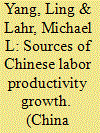

|
|
|
|
|
| Publication |
2010.
|
| Summary/Abstract |
We decompose labor productivity growth from 1987 to 2005 by examining six partial factors (both supply and demand): changes in value-added coefficients, labor inputs, shares of sectoral demands that are fulfilled domestically, input mix, and the intra-sectoral shares and intersectoral mix of final demand. Our analysis confirms that simply by virtue of its size and extremely low level of labor productivity, China's farm sector continues to weigh heavily in China's overall economic advances. Labor savings have levied the largest influence on the labor productivity on all sectors across all three study subperiods. We find that this transition is highly correlated with capital deepening that accompanies China's opening up process. Still, changes in the intra-sectoral shares and the intersectoral mix of China's final demand also have become quite strong, especially in recent periods. Due to ever-increasing competitive pressures as China continues to open, changes in industries value-added coefficients have tended to counteract some of the positive benefits of labor savings for most sectors. The effects on changes in labor productivity of technology change and changes in the use of imports have been comparatively negligible and any variation in their sectoral effects have been waning over time.
|
|
|
|
|
|
|
|
|
|
|
|
|
|
|
|
| 13 |
ID:
092835


|
|
|
|
|
| Publication |
2009.
|
| Summary/Abstract |
A complex system of production links our greenhouse gas emissions to our consumer demands. Whilst progress may be made in improving efficiency, other changes in the production structure may easily annul global improvements. Utilising a structural decomposition analysis, a comparative-static technique of input-output analysis, over a time period of around 30 years, net greenhouse emissions are decomposed in this study into the effects, due to changes in industrial efficiency, forward linkages, inter-industry structure, backward linkages, type of final demand, cause of final demand, population affluence, population size, and mix and level of exports.
Historically, significant competing forces at both the whole of economy and industrial scale have been mitigating potential improvements. Key sectors and structural influences are identified that have historically shown the greatest potential for change, and would likely have the greatest net impact. Results clearly reinforce that the current dichotomy of growth and exports are the key problems in need of address.
|
|
|
|
|
|
|
|
|
|
|
|
|
|
|
|
| 14 |
ID:
117327


|
|
|
|
|
| Publication |
2013.
|
| Summary/Abstract |
Methods to control China's CO2 emissions under its rapid economic development process have received much attention. As the top industrialized and urbanized region in China, Beijing is a good case to show the trends of CO2 emissions in China, and examining how different drivers influence the CO2 emissions direction of Beijing can give valuable insights to other regions on dealing with the emerging climate change issues. To this end, we conducted structural decomposition analysis to quantify the contributions of technological and socio-economic factors to the rapid CO2 emissions growth in Beijing from 1995 to 2007. An increasing final demand level and production structure change led to carbonizing Beijing significantly, while energy intensity improvement was Beijing's sole prominent source on decarbonizing its economic development in 1995-2007. Further, results highlighted the importance of trading and investment in CO2 emissions variations in Beijing. The industrial structure change toward heavy manufacturing and services sectors led to the significant role of these sectors in CO2 emissions growth in Beijing. Beijing's carbonizing process is a reminder to other regions in China to reconsider the direction of their industrial structure change and implement consistent and strict energy-saving policies.
|
|
|
|
|
|
|
|
|
|
|
|
|
|
|
|
| 15 |
ID:
168674


|
|
|
|
|
| Summary/Abstract |
Over the past few decades, Thailand has been one of the highly open economies and one of the most successful countries in applying the export-led growth model. At the same time, carbon dioxide (CO2) emissions released in Thailand tripled between 1990 and 2015. To examine how international trade plays a role in shaping Thailand’s CO2 emissions inventory, we compare emissions under both production-based and consumption-based accounting over 1990–2015 and disaggregate total CO2 emissions into traded and non-traded parts. We also use a multi-regional input-output database for performing a structural decomposition analysis (SDA) to investigate the factors contributing to changes in CO2 emissions. We find that Thailand continually stood out as a net carbon exporting country. CO2 embodied in exports accounted, on average, for 40% of domestically produced emissions. Our SDA results suggest that traded and non-traded emissions grew mainly due to increasing per-capita consumption in Thailand and abroad. The retarding effect from energy efficiency improvement was significant but not sufficient to reduce emissions.
|
|
|
|
|
|
|
|
|
|
|
|
|
|
|
|
| 16 |
ID:
185730
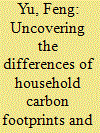

|
|
|
|
|
| Summary/Abstract |
Household carbon footprint is closely related with economic development level. Thus, to reveal the characteristic of household carbon footprint and its driving forces for countries under different development stage, this paper compared household carbon footprint and driving forces of developing China and developed Japan using input-output method and structural decomposition analysis method. Results show that China's household carbon footprint increased rapidly from 939 megatons (Mt) in 1997–3363 Mt in 2015, and then gradually decreased, while Japan's household carbon footprint fluctuated between 700–1000 Mt. In terms of per capita indirect household carbon footprint, it increased fast in China, but was still only less than 1/4 of that in Japan in 2018. Another finding is that food carbon footprint will decrease, while housing carbon footprint will increase with economic development. Transportation & communication can be a potential source for reducing such carbon footprints. In terms of driving forces of household carbon footprint, consumption expenditure was the major positive driving force and technology was a major negative driving force in China, while Japan was mainly driven by technology. It is suggested to pay attention to control the per capita household carbon footprint of fast developing countries, particularly transportation & communication consumption.
|
|
|
|
|
|
|
|
|
|
|
|
|
|
|
|
| 17 |
ID:
176740
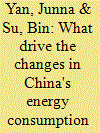

|
|
|
|
|
| Summary/Abstract |
During the 12th Five-Year Plan Period (2011–2015), the Chinese government has released a series of energy conservation plans to launch and deepen the transition in the energy use. Particularly, the dual control of the energy consumption and energy intensity was firstly emphasized. This paper intends to explore the targeted and effective energy policy implications through investigating the drivers of changes in energy consumption/intensity of China during the 12th Five-Year Plan Period. Under the input-output framework, the embodied energy consumptions/intensities by final demand category were estimated at aggregate/sector level and the total energy consumption/intensity was decomposed using the additive/multiplicative structural decomposition analysis. Among the final demand categories, China's energy consumption/intensity was mainly contributed by the investment, followed by the household consumption. According to the SDA results, China's total energy consumption increased by 28.8%, of which the energy intensity effect and the investment effect were the most retardant and accelerator, respectively. At the same time, China's total aggregate energy intensity decreased by 16.0%, of which the energy intensity effect and the household consumption effect were the most retardant and accelerator, respectively. In detail, the key sectors with respect to the critical effects were picked out. Above all, policy implications are discussed for achieving the energy goals during the 13th Five-Year Plan Period and launching the energy revolution during the 14th Five-Year Plan Period.
|
|
|
|
|
|
|
|
|
|
|
|
|
|
|
|
| 18 |
ID:
110383


|
|
|
|
|
| Publication |
2011.
|
| Summary/Abstract |
Investigating CO2 emissions of China's manufacturing centers contributes to local and global CO2 mitigation targets. This study considers Jiangsu Province as a representation of manufacturing centers in South China. Effects of material efficiency improvements, technology development, consumption structure changes and consumption volume growth in Jiangsu Province on its CO2 emissions during 1997-2007 are investigated using structural decomposition analysis based on environmental input-output table. In order to reduce CO2 emissions, Jiangsu Province should not only rely on material efficiency improvements and technology development, but also rely on consumption structure changes. For consumption structure changes in detail, Jiangsu Province should not only focus on fixed capital formation and urban residential consumption, but also focus on international and intranational imports and exports. For the implementation of material efficiency improvements and technology development, Jiangsu Province should focus on technology innovation and international technology transfer. For the implementation of consumption structure changes, Jiangsu Province should mainly focus on identified sectors for each separate final demand category: five sectors for urban residential consumption, three sectors for fixed capital formation, four sectors for international exports, five sectors for intranational exports, three sectors for international imports and four sectors for intranational imports.
|
|
|
|
|
|
|
|
|
|
|
|
|
|
|
|
|
|
|
|
|